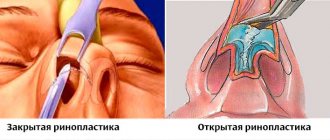For most women, sagging breasts are a serious aesthetic problem that prevents them from loving their own body and causes complexes, so the issue of treating mammary ptosis is especially pressing. Involutional aging processes, genetic predisposition and the minute-to-minute impact of the Earth's gravitational forces contribute to natural ptosis of the skin, body tissues and some internal organs. If we are talking about prolapse of the mammary glands, then in medicine it is called “ mastoptosis.”
" With mastoptosis, a woman’s breasts lose their elastic shape and look saggy. Special care for preventive purposes only helps to slow down the process of breast ptosis. This includes: contrast showers, massages, wraps, cosmetics, mesotherapy, biorevitalization of breast skin, as well as some other salon procedures. However, with severe mastoptosis, conservative methods are no longer effective. In this article we will talk about possible ways to treat mammary ptosis. The fastest and most effective of them is still mastopexy (mammopexy) - plastic surgery to tighten the mammary glands with or without the use of implants. But first, let’s look at why breasts sag in the first place: what factors contribute to this?
Causes of breast ptosis
The volume and appearance of a woman’s bust is determined by: the condition of the pectoralis major muscle and ligaments, the ratio of fatty and glandular tissue formed into lobules.
- Age-related changes - over time, after about 45 years, the process of fibro-fatty involution of the mammary glands begins in a woman’s body. It consists in the degradation of glandular tissue and its gradual replacement with adipose tissue. This occurs against the background of hormonal changes, which are especially active during menopause. These changes lead to a deficiency of the sex hormones estrogen and the gradual “fading” of the body. The synthesis of collagen and elastane, which are structural components of connective tissue, dermis and ligaments, slows down. As a result of fibrofatty involution, a woman’s breasts lose their aesthetically attractive appearance and, under the influence of the natural gravitational forces of the Earth, droop.
- Hereditary factor - congenital features of the synthesis of collagen and elastin determine the rate of tissue aging and predisposition to gigantomastia, and therefore to mastoptosis.
- Pregnancy and breastfeeding - during pregnancy, a woman’s breasts increase in volume due to the filling of the glandular lobules with milk. At the same time, the load on the ligaments increases, and the skin stretches. After completion of lactation, the volume of the gland gradually decreases. Due to stretching of the skin, the breasts look “empty” and saggy. In addition, uneven distribution of milk, as well as feeding a baby from one breast, can lead to noticeable asymmetry.
- Rapid weight loss or weight gain - fatty tissue not only actually determines the shape of the mammary glands. In case of rapid weight loss, part of the breast volume is lost, and the skin does not have time to recover. Adipocytes in adipose tissue store and synthesize hormones that are responsible for metabolism. On the contrary, rapid weight gain leads to an increase in the volume of the mammary glands and stretching of the skin.
- Endoprosthetics of the mammary glands with implants that are too large - breast ptosis after mammoplasty occurs the faster, the larger the prosthesis and the less elastic the skin.
- Smoking and alcohol abuse.
Factors to consider when changing bust sizes?
There are several reasons for reducing volumes. We will talk about them below. Now let’s pay attention to those factors that should attract the attention of every woman who cares about the beauty and health of her breasts:
- How drastic and rapid are the changes?
- Their cyclical nature (whether changes are related to menstruation or not).
- Are the changes related to diet, exercise, or occur independently?
- Is your body losing weight overall?
- Is your general health impaired or not?
- Is menopause close?
- Did the breasts “fall off” after lactation or is the process unrelated to this?
- Is the reduction due to loss of bust shape or not?
By understanding these factors, you can find clues to the correct answer to your main question. But in case of noticeable changes, it won’t hurt to see a mammologist. From a professional point of view, he can answer the question of why your breasts have “withered.”
Stages of mastoptosis
According to the classification proposed by American plastic surgeons, there are 3 degrees of mastoptosis.
Breast ptosis of the 1st degree is the initial stage of breast ptosis, in which the nipple is at the level of the submammary (inframammary) fold or slightly lower.
Breast ptosis of the 2nd degree - the nipple falls less than 3 cm below the inframammary fold.
Breast ptosis of the 3rd degree - the nipple is located more than 3 cm below the level of the fold and looks down.
False ptosis (mastoptosis) is characterized by the normal position of the nipples and sagging of the lower pole of the mammary glands - it is located under the submammary fold.
Puberty
Remember how in your youth you had to buy yourself a new bra more often than new notebooks. This is because breasts change very quickly during puberty, and the fact that they have started to grow means that estrogen levels are rising and the girl is entering puberty.
Along with the volume of the breast, the color and size of the nipples change, and for some time one breast may be larger than the other. Over the course of several years, while hormonal regulation continues, your breasts can grow and one day reach their fullest state.
Treatment of breast ptosis
With the help of physical exercise and diet, you can reduce the volume of fatty tissue, but this does not affect the condition of the connective and glandular tissue, which also gives the shape of the breast. In addition, with mastoptosis, the problem is also stretching of the skin.
On the contrary, breast lifting in the salon (mesotherapy, biorevitalization, massage and other cosmetic procedures) is aimed at improving the condition of connective tissue. These non-surgical methods require regular repetition and will not correct severe breast ptosis. Injections of vitamin complexes, hyaluronic acid and other active substances will help achieve a qualitative improvement in the condition of the skin, restoring the synthesis of collagen and elastane fibers. Cosmetic procedures can slow down the aging process and improve the appearance of the breasts, but they cannot correct breast ptosis or breast shape.
Acquired hypoplasia in teenage girls
Breasts can shrink not only in mature ladies and young mothers, but also in very young girls. In this case, the glandular tissue stops its growth and development. More often, hypoplasia or aplasia is congenital.
But this anomaly can also develop if the organ anlage is damaged in childhood:
- severe purulent mastitis in childhood;
- irradiation undertaken for the treatment of skin pathologies (nevus or hemangioma);
- scar changes after burns can inhibit the growth of glandular tissue;
- pathologies that led to surgery on the female genital organs and caused a decrease in estrogen production;
- metabolic disorders;
- history of anorexia or forced fasting.
Removing part of the gland surgically, while preserving part of its volume, can also cause atrophy of the remaining part and severe sagging. In this case, you will definitely have to see a doctor to restore the volume.
On this note, we bid you farewell. Visit our website and share our articles via social networks.
How to correct ptosis with a surgical lift (mastopexy)
In case of breast ptosis of the 1st degree, the bust can be restored to its beautiful shape with the help of endoprosthetics - an operation to enlarge it with implants. The problem of more advanced ptosis of the 2nd or 3rd degree is solved by mastopexy (mammopexy), that is, a breast lift. The essence of this plastic surgery is the resection of excess skin, fat and glandular tissue, as a result of which it is possible to raise the nipple-areolar complex. If there is insufficient volume of breast tissue, mastopexy can be combined with endoprosthetics and thus increase breast size. If a woman has noticeable asymmetry, it can be eliminated by combining a lift with reduction mammoplasty or endoprosthetics. In general, mastopexy is performed under general anesthesia for 1-3 hours.
There are three main methods of breast lift:
Periareolar mastopexy
It is used to eliminate mild and uncomplicated ptosis of 1st or 2nd degree. The plastic surgeon makes an incision around the areola to remove excess skin.
Vertical mastopexy
The method is used for breast ptosis of 2 and 3 degrees. The plastic surgeon makes two incisions: one around the areola, and the other vertically downwards from the circumference by 7-8 cm.
Anchor (or “T-shaped”) mastopexy
The most effective way to eliminate advanced stage 3 breast ptosis. The technique involves a composition of three neat incisions: vertical, around the areola and along the contour of the inframammary fold.
Types of micromastia
Usually, small breast size only brings aesthetic inconvenience to a woman. From a functional point of view, mammary glands of any size produce a sufficient amount of breast milk during lactation. In addition, breasts increase significantly during pregnancy and lactation. There are several types of micromastia in women:
- bilateral - both mammary glands are equally small in size, there is no pronounced asymmetry;
- unilateral - with this form of pathology, one mammary gland has a normal size and shape, and the second is significantly reduced.
There are complex forms of micromastia, when both breasts are reduced, but the degree of their development is different.
Why should a breast lift be done at the clinic? N.I. Pirogov?
Our plastic surgeons know how to correct breast ptosis, giving it a beautiful and toned shape again without noticeable post-operative scars. Look at the portfolio of our specialists and you will be convinced of this. Since 1999, doctors of the clinic named after. N.I. Pirogov in St. Petersburg successfully perform all types of operations on the mammary gland: from endoprosthetics to reconstruction after mastectomy. If, after some time, you are faced with the problem of breast sagging after primary mammoplasty, our plastic surgeons will not only solve this problem, but will take care of high-quality and long-term preservation of the result. We offer our patients:
- services of the city's leading plastic surgeons;
- medical offices equipped with modern equipment at the level of European private clinics;
- stay in comfortable wards for 1-2 people with meals, nursing care and round-the-clock supervision by a doctor on duty;
- special promotional offers (all inclusive) at affordable prices;
- own laboratory, which allows you to quickly obtain accurate diagnostic results, and intensive care;
- cosmetology department services, which can be useful for the prevention and treatment of mild breast ptosis;
- organizational assistance from a supervisor for patients from other cities.
Sex
When you're excited, your heart works harder, which allows blood to flow to your chest more than when you're at rest. As a result, the breasts become larger and more sensitive, the veins more expressive, and the nipples become hard. The fact that nipple arousal is associated with general arousal explains why many women can experience orgasm from breast stimulation alone.
How to tighten your breasts after childbirth?
Of course, the optimal method for correcting the shape of the mammary glands is surgical plastic surgery. But you can achieve a certain result using the following methods:
- Regular training with dumbbells or body weight.
- Film wraps and compresses after the usual cosmetic skin care procedures (warm shower, peeling, tonic creams).
- Traditional or water massage, contrast shower.
You shouldn’t expect dramatic changes from such methods, but you shouldn’t neglect the tips listed above. Constant and complete body care will reduce the negative consequences for the breasts in the postpartum period to a minimum.










